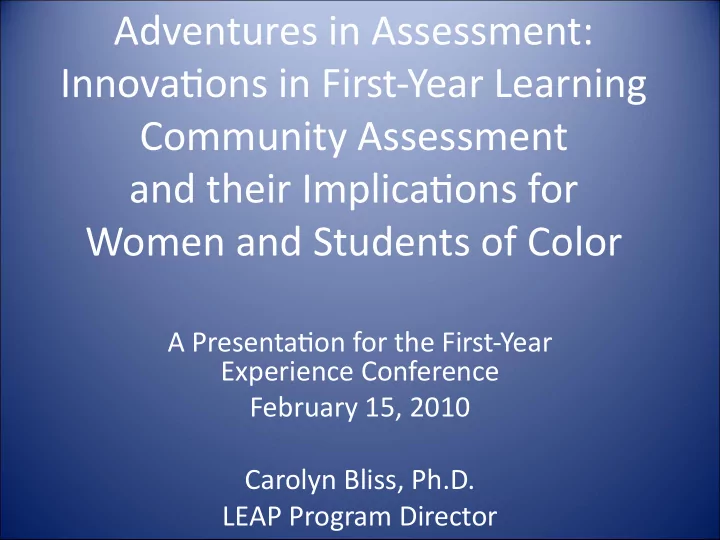

Adventures in Assessment: Innovatjons in First-Year Learning Community Assessment and their Implicatjons for Women and Students of Color A Presentatjon for the First-Year Experience Conference February 15, 2010 Carolyn Bliss, Ph.D. LEAP Program Director
The LEAP Program • Begun in 1994 with around 100 students • Nearly 1000 today • 27 fjrst-year sectjons, 12 faculty • All sectjons study the intersectjons of community and diversity
The LEAP Program (cont.) • 2-semester course keeping students with the same classmates and instructor • Three graduatjon requirements fulfjlled (including diversity) • Linked courses in writjng, library research, service learning, and major selectjon • Sophomore alums become Peer Advisors
The LEAP Program (cont.) • Sectjons for undecided majors, residence hall students, and students interested in service • Pre-Professional tracks in – Architecture – Business – College of Health – Educatjon – Engineering – Fine Arts
The LEAP Program (cont). • Multj-year LEAPs for underrepresented students in: – Engineering – Health Sciences – Pre-Law
The LEAP Program (cont.) • Sectjons underdevelopment for: – A mix of internatjonal and American students – Non-traditjonal students, including returning service men and women – Science majors
Assessment of LEAP Before 2005 • Standard student course evaluatjons • Pre-and post surveys measuring student satjsfactjon
Percent of LEAP vs. Non-LEAP students answering "Very Greatly" or "Greatly" to questjons 17-34 on the 2005-2008 Senior Surveys
Matching Criteria for the Twin Study • Year student entered the University (cohort) • High school student graduated from (as a proxy for socio-economic status) • Ethnicity or race • Age • Gender • Admissions Index (a composite of SAT or ACT score and high school GPA)
Demographics for the Matching Study • 1491 pairs • Entering the U between fall semesters 1999 to 2006 • 53% female; 47% male • 96% Caucasian; 4% students of color
Hypotheses of the Matching Study • LEAP students will outperform their non- LEAP demographic “twins” on the dependent variables listed below.
Dependent variables for matching study subjects •First and second semester GPA •First and second semester attempted and completed credits •Fall-Fall retention rate •Most recent (last) GPA (all students, all courses) •Graduating GPA (for those who have graduated) •Graduation Rate at four and six-year mark
Adding the Major as a Matching Criterion • LEAP Matching Study by College Major: 117 pairs – LEAP women have signifjcantly higher 1 st and 2 nd semester completed credits. – LEAP men are signifjcantly less likely to have graduated.
Adding the Major as a Matching Criterion • LEAP Matching Study by Department Major: 51 pairs – No statjstjcally signifjcant difgerences between LEAP and non-LEAP women. – Non-LEAP men signifjcantly outperform LEAP men on GPA in the fjrst semester.
Assessment Findings for PAs • 29 PAs matched with 170 LEAP and non-LEAP students • First semester GPAs: – Non-LEAP 3.00 – LEAP 3.18 – PAs 3.66 • First semester credits atuempted: – Non-LEAP 11.35 – LEAP 12.09 – PAs 12.90 • First semester credits completed: – Non-LEAP 11.17 – LEAP 11.79 – PAs 12.86
First Semester Experience b=PA sig > Non-LEAP; c=PA sig > LEAP; sig= p<.05
Assessment Findings for PAs (cont.) • Second semester GPAs: – Non-LEAP 3.08 – LEAP 3.19 – PAs 3.51 • Second semester credits atuempted: – Non-LEAP 11.13 – LEAP 11.44 – PAs 13.00 • Second semester credits completed: – Non-LEAP 11.43 – LEAP 11.46 – PAs 12.87
Second Semester Experience b=PA sig > Non-LEAP; c=PA sig > LEAP; sig= p<.05
Assessment Findings for PAs (cont.) • Overall GPAs: – Non-LEAP 3.12 – LEAP 3.12 – PAs 3.46 • Graduatjon rates to date: – Non-LEAP 20% – LEAP 22% – PAs 45%
Overall GPA’s b=PA sig > Non-LEAP; c=PA sig > LEAP; sig= p<.05
Graduatjon Rate b=PA sig > Non-LEAP; c=PA sig > LEAP; sig= p<.05
Tentatjve Conclusions • LEAP and non-LEAP twins, even when matched for major, perform at least equally well later in their college careers. • Early difgerences observed may result from mismatches: Students choosing LEAP may have unrealized potentjal. • OR our ‘n’ may be so low because more of the non-LEAP ‘twins’ have lefu school, and more LEAP students have stayed.
Tentatjve Conclusions (cont.) • Both possibilitjes are supported by results from administratjon of the Student Readiness Inventory to one entering cohort. • LEAP should be made more aturactjve to men, perhaps by emphasizing the program’s promotjon of success as well as community. • Data collectjon and analysis must contjnue.
Recommend
More recommend